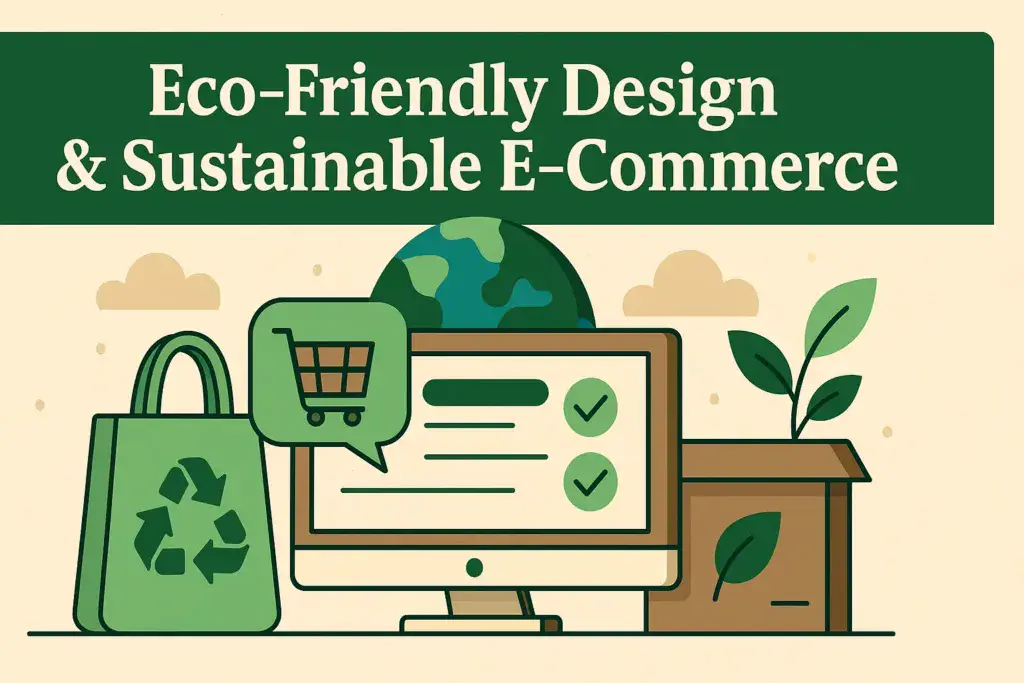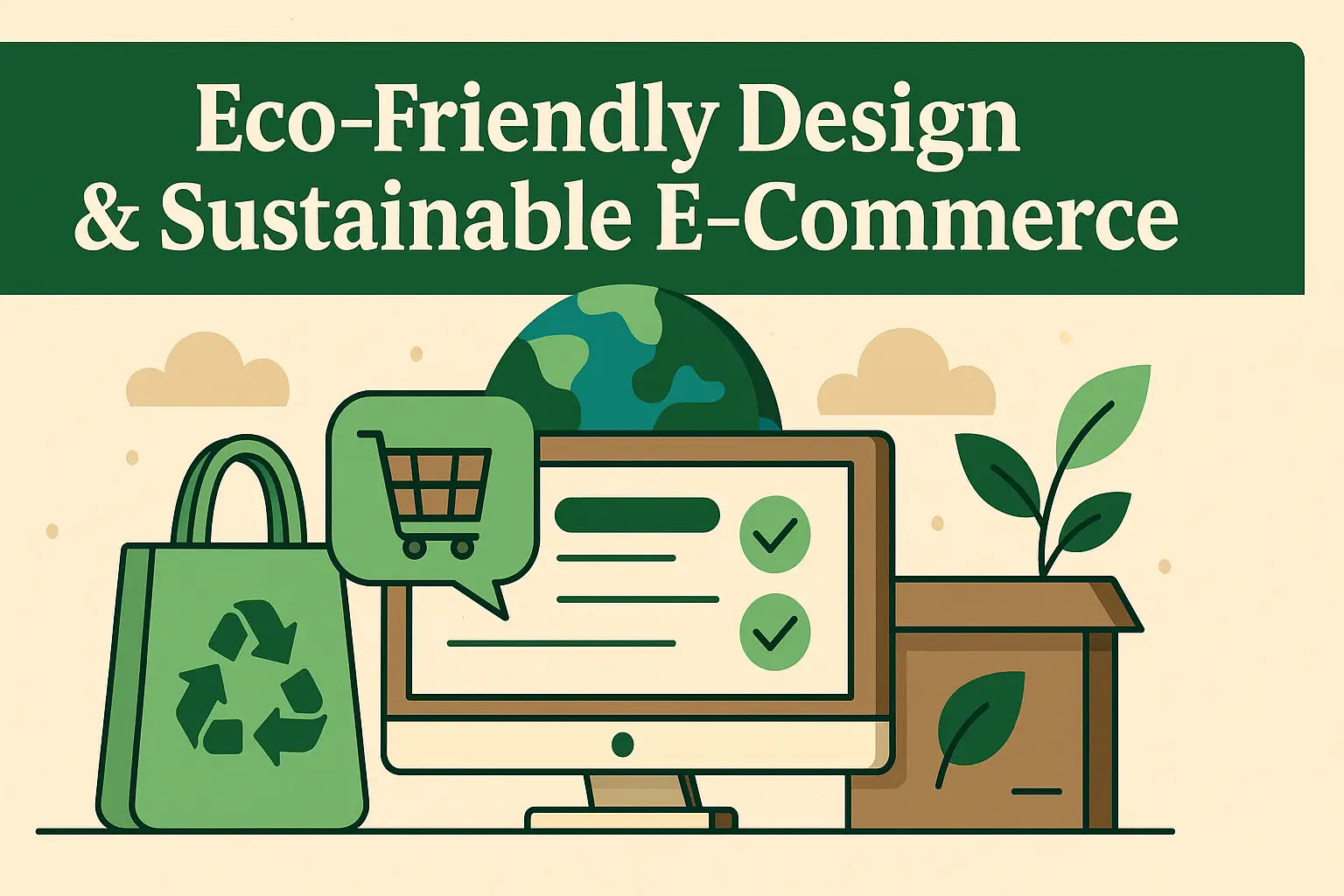
Introduction: Why Sustainable E-Commerce Design Matters Today
The digital marketplace is evolving at a staggering pace, and one of the strongest forces driving this change is the growing demand for sustainable e-commerce design. What was once a niche concept embraced only by eco-friendly startups has now become a mainstream necessity. Consumers are no longer satisfied with convenience and competitive pricing alone—they want brands that align with their values and demonstrate a tangible commitment to the planet.
As research by the Baymard Institute highlights, practices like dedicating space for sustainability stories or including “green” checkout options are now considered must-haves in sustainable e-commerce design.
The era of sustainable e-commerce design is about more than eco-friendly packaging or planting trees for every order. It’s a holistic rethinking of how online stores are built, operated, and experienced—from supply chain transparency and digital infrastructure to design choices that minimize waste and maximize customer satisfaction. Companies that prioritize sustainability are not only making an ethical choice but also securing long-term growth in a marketplace where conscious consumerism is a dominant force.
Brands like Patagonia and Allbirds have become household names in part because of their leadership in sustainable e-commerce design. By proving that environmentally responsible practices can go hand in hand with profitability, they’ve inspired a wave of businesses to reimagine their own operations. This is no longer just about branding—it’s about survival, reputation, and future-proofing.
Principles of Sustainable E-Commerce Design and Their Importance
At its foundation, sustainable e-commerce design is built on the idea that digital commerce can and should reduce harm to the environment while enhancing customer experience. This means creating websites, products, and shopping journeys that conserve resources, minimize waste, and deliver meaningful value to consumers.
One of the most important principles of sustainable e-commerce design is transparency. Customers expect to know where materials come from, how products are made, and what brands are doing to reduce emissions. Sustainable design isn’t just about functionality; it’s about fostering trust. When businesses communicate openly about their sustainable practices, they strengthen their credibility and set themselves apart in a crowded marketplace.
Another principle is efficiency. By optimizing logistics, streamlining packaging, and reducing digital overhead such as heavy website elements that slow down load times, businesses align with both ecological goals and user experience improvements. In fact, even something as simple as faster-loading, lightweight websites contributes to the philosophy of sustainable e-commerce design—because it reduces energy use across servers and devices globally.
Most importantly, sustainable design must be integrated into the brand identity. A company that uses recycled packaging but ignores carbon-heavy shipping practices is missing the bigger picture. To be effective, sustainable e-commerce design must be a 360-degree commitment that touches every aspect of business strategy.
Tech Innovations Driving Sustainable E-Commerce Design
Technology is the single biggest accelerator of sustainable e-commerce design. Without it, scaling eco-friendly practices across thousands of products and millions of customers would be impossible. Thankfully, emerging tools are giving businesses a new edge in aligning profits with planet-first strategies.
AI and machine learning are at the forefront. They help businesses anticipate demand, manage inventory, and reduce overproduction—one of the largest contributors to waste in retail. By ensuring products are produced in the right quantities at the right time, AI directly supports the goals of sustainable e-commerce design.
Blockchain technology is another game changer. Greenwashing is a significant threat to consumer trust, and blockchain provides verifiable proof of sustainability claims. By tracing materials and verifying ethical sourcing, blockchain helps ensure that sustainable e-commerce design is rooted in fact, not marketing spin.
E-commerce platforms like Shopify and BigCommerce are embedding sustainability tools into their systems. These include carbon footprint calculators, eco-friendly shipping recommendations, and integrated analytics that help businesses measure and reduce their impact. These innovations demonstrate how sustainable e-commerce design is becoming less of an optional feature and more of a standard expectation.
Even product design is evolving thanks to advanced software that prioritizes low-impact materials and processes. Companies are experimenting with biodegradable textiles, 3D printing with recycled inputs, and modular product designs that encourage repair instead of disposal—all innovations directly aligned with the future of sustainable e-commerce design.
Challenges Faced by Sustainable E-Commerce Design Ventures
Despite its many advantages, sustainable e-commerce design comes with challenges that businesses must navigate carefully.
High upfront costs are perhaps the most significant barrier. Implementing sustainable materials, energy-efficient systems, and transparent supply chain technologies can be more expensive than sticking with traditional practices. For small businesses, these investments can feel overwhelming, even though they often result in savings and efficiency over the long term.
Balancing cost and consumer expectations is another challenge. While shoppers want eco-friendly products, they also demand affordability. This creates pressure for businesses to innovate without pricing themselves out of the market. The key to successful sustainable e-commerce design lies in clearly communicating the value of eco-conscious practices so customers understand that they’re paying for more than a product—they’re investing in a movement.
Greenwashing is a critical issue. Some brands exaggerate their eco-friendly credentials to attract customers, which undermines genuine efforts by responsible businesses. Companies committed to authentic sustainable e-commerce design must provide transparency, certifications, and measurable results to build lasting trust.
Finally, supply chain complexities present ongoing challenges. Ensuring that every partner in the production and delivery process aligns with eco-friendly standards requires diligence and continuous monitoring. For global operations, this can be daunting, but it is also a crucial part of building a credible reputation in the field of sustainable e-commerce design.
The Future of Sustainable E-Commerce Design: Trends and Predictions
The trajectory of sustainable e-commerce design is clear—it’s moving from trend to requirement. Consumers are demanding more transparency, regulators are enforcing higher standards, and brands that fall behind risk irrelevance.
One of the most promising trends is the rise of the circular economy. Products are increasingly being designed with longevity, reuse, and recyclability in mind. In the context of sustainable e-commerce design, this means offering take-back programs, repair services, and resale platforms that extend the lifecycle of products.
Another future trend is hyper-transparency. As blockchain and other verification technologies advance, consumers will expect full access to the story behind every product—from raw material to doorstep delivery. Brands that embrace this level of openness will find themselves at the forefront of sustainable e-commerce design.
Collaboration is also becoming a defining feature of the future. Businesses will partner not only with suppliers but with governments, NGOs, and even competitors to establish sustainable standards. This cooperative approach amplifies impact and reinforces the importance of sustainable e-commerce design as a collective responsibility.
In the years ahead, sustainability will no longer be a differentiator—it will be the default. The businesses thriving in that landscape will be those that committed early and made sustainable e-commerce design part of their DNA.
Conclusion: The Lasting Impact of Sustainable E-Commerce Design
The call for sustainable e-commerce design is louder than ever, and it’s reshaping the future of online business. What started as a movement among eco-conscious pioneers has become a global standard that all businesses must adopt if they want to stay relevant.
By integrating sustainable e-commerce design into every aspect of operations—from website development to logistics, from product innovation to customer communication—brands not only reduce their environmental impact but also build stronger, more loyal relationships with their customers.
The conclusion is clear: businesses that prioritize sustainable e-commerce design aren’t just preparing for the future—they’re creating it.




Thank you for this very educational article, Thierry. Eco-friendly e-commerce has become more than a trend. Eco-friendly e-commerce should also include eco-friendly packaging, reduction of shipping emissions, and, of course, minimizing waste. We have already witnessed minimizing waste with the many recycling operations being implemented. Providing accurate product descriptions and understandable sizing guides can reduce product returns, which creates additional packaging and unnecessary extra shipping needs. Thank you again for your very interesting post.
Best wishes,
Kent
Hi Kent,
Thank you so much for your kind and insightful feedback! You’re absolutely right—eco-friendly e-commerce goes far beyond just the “green” label. Your points about packaging, shipping emissions, and minimizing returns through better product info are incredibly important. I especially appreciate your mention of recycling operations—it’s encouraging to see so many businesses finally aligning logistics with sustainability goals.
Accurate descriptions and sizing guides are underrated but powerful tools for reducing environmental impact. It’s a reminder that great UX and sustainability often go hand in hand.
Wishing you continued success on your own journey—and thank you again for contributing to the conversation!
Warm regards,
Thierry
The principle of designing for durability and longevity, rather than just aesthetics, is a shift in mindset that can make a real difference in reducing waste. The focus that you mention on using customer education to encourage product care and repair is a practical way to extend the life of items.
Businesses might not immediately see how transparent communication about a product’s entire lifecycle, including end-of-use options, can actually build stronger customer trust and loyalty.
You mentioned the importance of carbon-neutral shipping options. How do you typically help businesses evaluate and choose the most credible partners for offsetting their shipping emissions? Also, for the modular design approach, what are some of the biggest challenges in creating products that are both easy to disassemble and aesthetically appealing?
Thank you for such a thoughtful response—you really captured the spirit of designing for impact rather than just for looks.
On carbon-neutral shipping partners, I typically guide businesses to evaluate providers based on third-party certification (like Gold Standard or Verra), traceability of offset projects, and transparency around pricing. It’s crucial to look for providers that integrate seamlessly into shipping workflows and offer reporting tools to track actual impact. Services like Pachama, Planet by Shopify, or Carbonfund.org often come up depending on the business size and location.
As for modular design, you’re absolutely right—it’s a balancing act. One of the biggest challenges is maintaining structural integrity and visual cohesion while ensuring components are easy to disassemble. Businesses often struggle to find the right materials that support repeated assembly/disassembly without degrading over time. There’s also the design complexity of hiding joins, fasteners, or repair mechanisms without compromising the visual aesthetic. But when done well—like in some recent circular fashion or electronics cases—it creates huge potential for upgrades, customization, and emotional durability.
Would love to hear your thoughts on any standout examples you’ve come across in this space!
Thierry